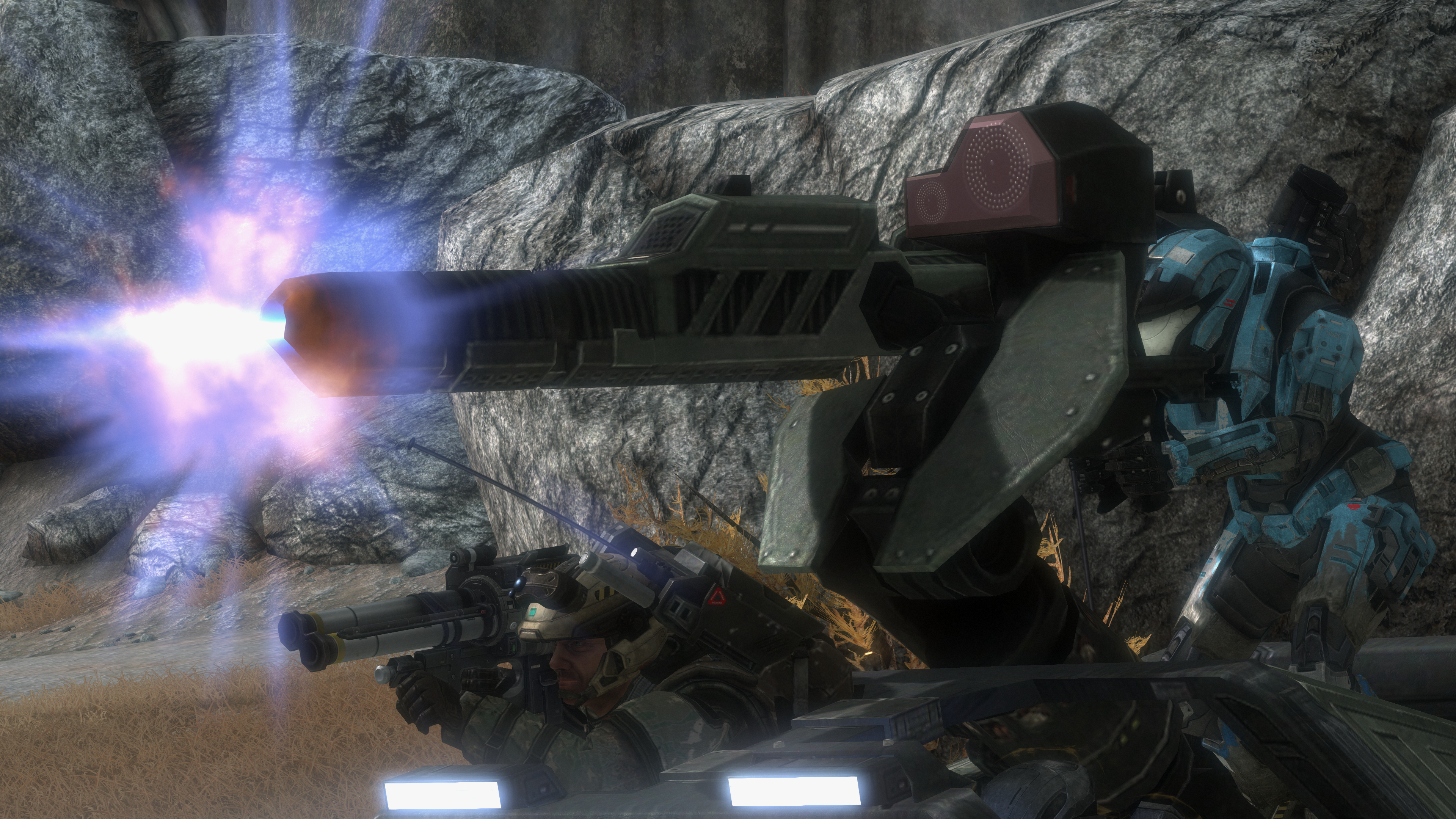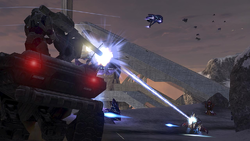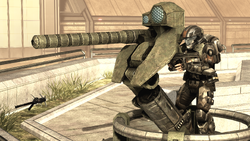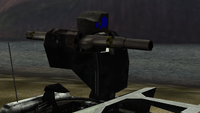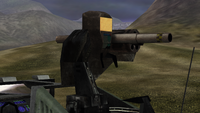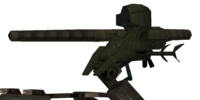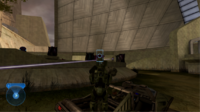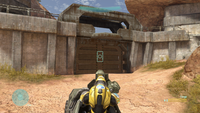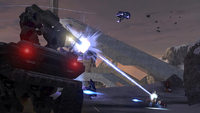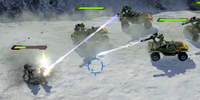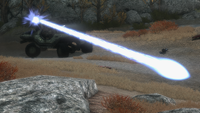M68 Gauss cannon
From Halopedia, the Halo wiki
| M68 Asynchronous Linear-Induction Motor | |
|---|---|
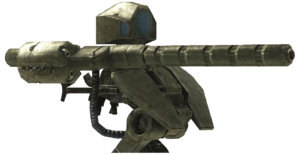
| |
| Production overview | |
|
Manufacturer: |
|
|
Type: |
|
| Specifications | |
|
Length: |
|
|
Weight: |
110 kilograms (243 lb)[2] |
|
Ammunition type: |
|
|
Capacity: |
750 rounds[2] |
|
Effective range: |
|
The M68 Asynchronous Linear-Induction Motor is a model of Gauss cannon used by the armed forces of the United Nations Space Command. While overshadowed by its more common M68B variant, the M68 was used during the Human-Covenant War as an anti-armor weapon capable of firing hypervelocity, high-density projectiles. Also known among the troops as the "68," "Rail Gun," "Tent Pole," and the "Gas Gun,"[2] it can be mounted on a stationary stand, or mounted on a vehicle. In the vehicle-mounted role, it is most famous as an armament on the M12G1 "Gauss" Warthog.
Overview[edit]
Design details[edit]
Despite its name, the M68 does not operate as a Gauss gun, instead named after the 19th century mathematician Carl Friedrich Gauss - the pioneer for the underlying technology behind the weapon.[4][5] As with other Gauss cannons, the M68 fires using asynchronous linear induction motors; using staged electromagnets that turn on-and-off in sequence to accelerate the projectile inside the barrel up to hypersonic velocities.[2][6][7] [8] In practice, this is similar to the much larger naval coilgun turrets and Magnetic Accelerator Cannons used on UNSC starships as heavy space combat weapons, or the smaller Stanchion series of handheld coilgun anti-materiel weapons. In this respect, it is sometimes informally termed a "mini-MAC".[9]
The weapon overall measures 3.0 meters (9.7 ft) in length,[1][Note 1] with a barrel length of 2 meters (6.6 ft).[8] It has a very similar design to the older M65 Gauss cannon used by the Colonial Military Authority, though unlike the M65 has a re-centred optics module and an integrated body shield that can protect the operator from incoming frontal fire.[1] The optics module consists of two large lenses which are connected to a firing computer in the weapon itself. The user is displayed a screen that shows a readout of what the gun can see alongside a heads-up display for aiming.[10] The Gauss cannon is additionally capable of smart-linking to a heads-up display such as that in MJOLNIR Powered Assault Armor, allowing an operator to project the weapon's reticle even when the optics package is not available.[8]
When fired, the Gauss cannon's projectiles cause an ear-splitting sonic boom as they accelerate[8] - personnel stood within 20 meters (66 ft) of the weapon when it is fired may suffer permanent hearing damage if they do not have hearing protection.[2] As the projectile travels through the air, it emits a burst of intense blue-white light due to the friction of the round heating up.[8] The speed of the projectile is such that they appear instantaneous to the human eye,[1] and impact their target before the operator has even finished pulling the trigger.[8]
Ammunition[edit]
The M68 Gauss cannon fires a ferric-tungsten 25x130mm round. These are fed into the weapon by a rotating cylindrical magazine towards the back of the barrel capable of holding 750 rounds.[2]
There are a number of ammunition types available, depending on use case.
- 25x130mm Armor-Piercing, Limited Penetration/Frangible (APLP/F)[2]
- M485 25x130mm High-Velocity/Ferric-Tungsten Hollow-Point Projectile (HV/FTHPP).[6][7]
Variants[edit]
There are half a dozen design variants of the M68 ALIM platform, all of which are produced by Misriah Armory.[6] However, the most common is the M68B variant of the Gauss cannon - one which eclipsed the standard M68 and became the most commonly-used Gauss cannon of both the UNSC Army and UNSC Marine Corps during the Human-Covenant War. The M68B has a distinctive silhouette, with a bulkier power feed architecture and cooling system.[1]
Catherine-B320 operating an M68B Gauss cannon during the Battle of Sword Base.
An M68B Gauss cannon mounted on an M12B Warthog chassis.
Usage[edit]
The M68 was originally introduced into UNSC service to provide anti-armor and anti-materiel support over long distances. However, the versatility and control of the emplacement ultimately made it a principle component of mechanised vehicle squads specialising in hunter-killer and anti-tank roles.[1] They may also be used in a limited anti-aircraft role; Gauss Warthog teams attached to remote units drill for use in both anti-tank and anti-air duties.[11]
The Gauss cannon's intended role is similar in nature to that of the M39 rocket turret, with both the M12G and M12A Warthogs respectively having the formal designation of Light Anti-Armor Vehicle. The turret's versatility means it can be employed on any vehicle capable of accepting a standard Warthog turret; this includes the aforementioned M12G Warthog, the M650 Mastodon and the M35 Cougar - the latter of which boasting dual M68s in a rotating turret atop the vehicle. Stationary mounts are also used.[12]
Operational history[edit]
M68s were used throughout the entirety of the Human-Covenant War, from its earliest battles to the final engagement of the conflict on Installation 00. In 2526, a half-dozen Gauss cannons were used by Spartan-II Blue Team during the Battle of Mesra. During the fighting, the Militia of Mesra's Gauss Warthogs were destroyed, leading to Blue Team tearing the M68 cannons off the vehicles and using them as handheld weapons. Due to the sheer size of the Gauss cannon, they could only be fired prone, leading Blue Team to set up firing positions in the Karpos Mountain Range overlooking the Samalat Gorge. From here, they used their Gauss cannons to fire down on a large Covenant convoy of Wraiths, bridging vehicles and support vehicles, before being forced to retreat by the enemy's Yanme'e defences.[3][8] M68s also played a role in the Harvest campaign, and were heavily used by the ground forces deployed by UNSC Spirit of Fire throughout 2531 including the aforementioned war on Harvest alongside the Battle for Arcadia and Battle of Trove.[13] Sergeant John Forge in particular deployed into battle using a Gauss Warthog, often choosing to man the gun directly.[14][15]
Towards the end of the war, M68 Gauss cannons were used in the Battle for Earth, seeing use by John-117 and by the defenders of the ONI Alpha Site in the early stages of the Battle of Mombasa.[16][17][18] They continued to be used later after UNSC-seperatist forces deployed to the Ark, being used in the push for the installation's Cartographer and later, the Citadel.[19][20]
During the Carrow Conflict in 2556, Spartan Gray Team used an M68 in combination with a HAVOK tactical nuclear weapon in order to create a weapon capable of firing an electromagnetic pulse. The nuclear weapon was used to provide additional power for the Gauss gun, while the weapon itself was modified to emit the EMP.[21] It was used against Hekabe and his Sharquoi legion by disabling the Forerunner technologies that enabled their control, though after firing once the gun was burnt out.[22]
In-game information[edit]
- Main article: Gauss Turret (gameplay)
The Gauss Cannon made its in-game debut in Halo 2, first showcased in the Halo 2 E3 demo and using the design of a rocket launcher cut from Halo: Combat Evolved (see production notes for more details). It functions as an extremely powerful turret that can kill enemy heavy vehicles in a handful of a shots. Since then it was featured in Halo 3 and Halo 3: ODST fundamentally unchanged, though ODST introduced a stationary turret variant of the weapon, allowing it to be used in circumstances outside of on the back of a Warthog.
In Halo Wars, the M68 is featured as the final upgrade available for the Warthog unit. It can be purchased at the Firebase with the following requirements:
- Info: Upgrades Warthog machine gun to a gauss cannon. Improves damage and defense.
- Tier:
 3
3 - Cost:
 0,
0,  800 (400 for Professor Anders)
800 (400 for Professor Anders)
In later games from Halo: Reach onward, the M68 Gauss cannon was replaced by the M68B Gauss cannon and M70 Gauss cannon.
Production notes[edit]
The Gauss cannon's design originates in the pre-Xbox era of Halo: Combat Evolved's development. At this early stage of production, Halo was intended to feature a Rocket Warthog, fitted with a turret with an extraordinarily similar design to that of the M68 Gauss cannon. The Rocket Warthog was ultimately cut from Halo, with an alternate rocket turret design created when the game was ported to PC. As such, when Halo 2 was in production, the Rocket Turret's design was brought back, now-reworked as the Gauss cannon.
According to Bungie designer Tyson "ferrex" Green, the Gauss cannon's Halo 2 sound effects were taken from that of a railgun firing. This was intentional, as the railgun's sound effects were "too cool not to use", despite operating on a different electromagnetic principle.[23]
Disrepancies[edit]
- The muzzle velocity of the M68 has been up for some dispute between sources. Early sources including the Halo: Evolutions short story Palace Hotel and Halo: The Essential Visual Guide note the Gauss cannon's muzzle velocity to be Mach 40 - a massive number well beyond the escape velocity of Earth, and unrepresentative of the cannon's projectile seen in the Halo games.[5][9] More recent sources, including the 2009, 2011, and 2022 editions of the Halo Encyclopedia alongside the novel Halo: Oblivion, have toned down this figure significantly, noting that Gauss cannons fire their projectiles at hypersonic speeds - AKA Mach 5 or over.[2][6][8] However, one page of the 2022 Encyclopedia seemingly-erroneously mentions the M68 as firing at speeds "approaching Mach 1" - an unrealistically low figure that may be a typo intended to say Mach 10.[1] As such, this page uses the "hypervelocity" statements as the most consistently-depicted fact.
- In the 2009 and 2011 editions of the Halo Encyclopedia, the M68's length was noted as 291 centimeters (114.7 in).[2] This figure was updated in the 2022 edition to 3.0 meters (9.7 ft).[1]
Gallery[edit]

|
Browse more images in this article's gallery page. |
The M68 Gauss cannon in the Halo 2 E3 Multiplayer Demo.
A Gauss slug of the M68 Gauss cannon from The Art of Halo 3.
A Gauss Warthog on Last Resort in Halo 3.
The Rookie inspecting a destroyed Gauss cannon in Halo 3: ODST.
Gauss cannons in Halo Wars.
Kat fires a Gauss cannon at a Rizvum-pattern Revenant in Halo: Reach.
List of appearances[edit]
- Halo 2 (First appearance)
- Halo: Uprising
- Halo 3
- Halo Wars
- Halo 3: ODST
- Halo: Evolutions - Essential Tales of the Halo Universe
- Halo: Envoy
- Halo: Retribution (Mentioned only)
- Halo: Oblivion
- Halo: Hippocratica
Notes[edit]
- ^ Jump up to: a b c See production notes for disrepancies
Sources[edit]
- ^ Jump up to: a b c d e f g h i j Halo Encyclopedia (2022 edition), page 181
- ^ Jump up to: a b c d e f g h i j Halo Encyclopedia (2011 edition), page 321
- ^ Jump up to: a b Halo: Oblivion, chapter 1
- ^ Halo Waypoint, Gauss Technology (Retrieved on Oct 6, 2011) [local archive] [external archive]
- ^ Jump up to: a b Halo: The Essential Visual Guide, page 78
- ^ Jump up to: a b c d Halo Encyclopedia (2022 edition), page 137
- ^ Jump up to: a b Halo Waypoint, The New Halo Encyclopedia is Out Today (Retrieved on Mar 16, 2025) [archive]
- ^ Jump up to: a b c d e f g h Halo: Oblivion, chapter 3
- ^ Jump up to: a b Halo: Evolutions - Palace Hotel
- ^ Halo 3, Gauss Turret in-game weapon
- ^ Halo 5: Guardians, REQ card: Tundra Gauss Warthog "Gauss Warthogs attached to remote garrison units serve as both anti-armor and anti-aircraft vehicles, and their driver/gunner pairs drill for both tasks. Improved Gauss Warthog with extra armor."
- ^ Halo 3: ODST, Gauss Turret in-game weapon
- ^ Halo Wars, Gauss Turret in-game weapon
- ^ Halo Wars, campaign level Arcadia City
- ^ Halo: Hippocratica
- ^ Halo 2, campaign level Metropolis
- ^ Halo 3: ODST, campaign level ONI Alpha Site
- ^ Halo 3: ODST, campaign level Coastal Highway
- ^ Halo 3, campaign level The Ark
- ^ Halo 3, campaign level The Covenant
- ^ Halo: Envoy, chapter 22
- ^ Halo: Envoy, chapter 25
- ^ Bungie.net Forums, Subject: I found why the wrthog gauss cannon is called gauss.: "While the Warthog gauss rifle is modeled as a magnetic acceleration cannon, the sound and effects are actually those of a railgun, which operates on a different principle. However, the sound and effects were so cool that we couldn't not use them." - Tyson Green (Retrieved on Mar 26, 2009) [archive]
| ||

